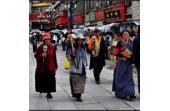Barkhor Street
- Things to do
-
- Photo(10)
- Tips&article(10)
- Make it Happen
- Map
-
loading...
The Barkhor (pilgrims’ circuit) is found in the heart of Lhasa encircling the Jokhang Temple. It was built about 1,300 years ago, and it developed with the Jokhang Temple. It dates back to the foundation of the Jokhang and is an essential pilgrim route.
In the past, it was a designated circumambulation circuit, "a saint road" in the eyes of Tibetans. Now it's also a shopping center, an old district with colorful Tibetan features. The streets of the Barkhor have recently been widened and a wide area, called Barkhor square, was created in front of Jokhang Temple.
Tibetan houses line the streets, and the ground is paved with flagstones, preserving the ancient look. In the street, you can find souvenirs, and experience the mysterious "one step one bow" way to religion. Houses and small inns were built all around the street. All the houses along the street are stores.
As time went on, shops and businesses set up in the Barkhor, and it slowly became a prosperous area. All kinds of fantastic commodities show us all aspects of the Tibetan life, such as prayer wheels, bronze Buddhist statues, prayer beads, joss sticks, carpets, knives, and Thangkas. Commodities from nearby countries such as India, Nepal and Burma can also be found there.
Barkhor Street bustles with activity. It is a must for souvenir-hunting tourists. Many people call the Barkhor "the window of Tibet" as it exhibits a typical Tibetan life. The old circumambulation circuit is always crowded with pilgrims from everywhere. Some progress along the road by performing body-long obeisances, some come by truck.
Some are monks, and some are businessmen from Kham, a region encompassing East Tibet and part of Sichuan Province. Here you will find people from all over Tibet. You can experience different styles of dress and languages. Even the similar-looking clothes of the monks vary depending on the different branches of Buddhism they practice.
Related Readings
- Photos of Barkhor Street
- Tibet Travel Tips
- Tibet Tour Packages
- Watch videos of Tibet
How to Get to there?
Tips & articles
|
|
|
forum discussion
|
|
|










